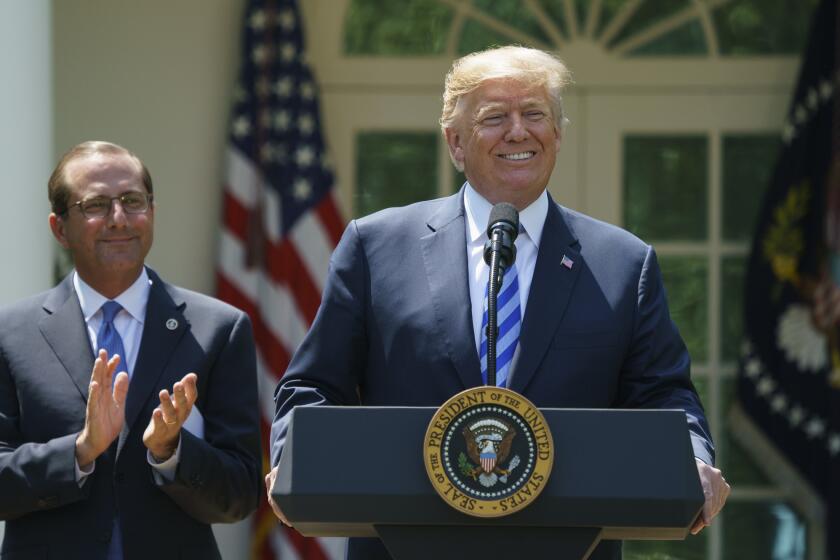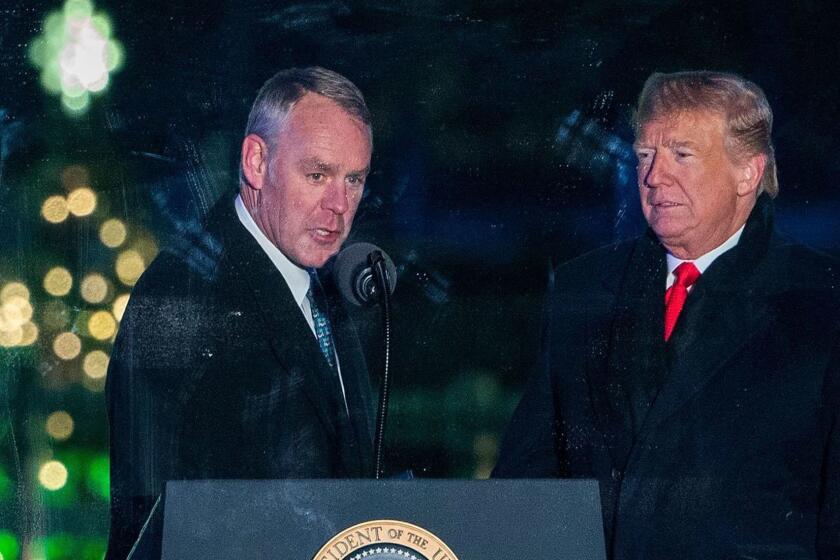Column: Trump’s trashing of NOAA’s scientific reputation is part of his war on science

- Share via
The evidence that President Trump views America’s weather forecasting infrastructure not as an important scientific asset but as an opportunity for grift dates back to late 2017, when he nominated Barry Myers as director of the National Oceanic and Atmospheric Administration.
NOAA was not then the household name it has become, though its services were well known to the public. An arm of the Commerce Department, it’s the parent of the National Weather Service, which in turn is the parent of the National Hurricane Center and the Storm Prediction Center, which forecasts violent thunderstorms and maintains a tornado watch.
Myers was the CEO of AccuWeather, a Myers family business that allegedly had been trying to get the the government to restrict NOAA’s work, largely because services provided by the weather service, a NOAA agency, compete with AccuWeather’s business of offering similar services for a price.
The mood at NOAA was that they’d narrowly escaped what’s going on at the EPA and Interior. But this puts everyone there in the spotlight in a really negative way.
— Andrew Rosenberg, Union of Concerned Scientists
As we reported in May, the Myers appointment raised fears that it would snare NOAA in a massive conflict of interest. The nomination has remained in limbo ever since, though it could be brought to the Senate floor for confirmation at any time by a wave of Senate Majority Leader Mitch McConnell’s hand. In the meantime, NOAA has been led by a succession of acting directors, the latest of whom, Neil Jacobs, came to the job bearing his own trail of potential conflicts of interest.
The harvest of that mess has lately been on public display. NOAA has been dragged into the controversy Trump triggered with his inaccurate claim that Hurricane Dorian threatened Alabama. The agency’s credibility is in tatters. It’s murky what role Jacobs had in the statement that was issued by the agency Sept. 6 supporting Trump’s version of events and upbraiding the weather service’s Birmingham, Ala., bureau.
It may be getting harder to gauge the potential ethical conflicts of President Trump’s appointees without a scorecard and calculator, but here’s a candidate boasting what critics say could be the most direct conflict of interest of anyone poised to join the administration.
But what amounts to an attack on the credibility of a government scientific agency fits the pattern in the Trump administration of trashing scientific agencies, such as the Environmental Protection Agency and units of the Interior Department, that don’t hew to the White House view of the world. The Dorian affair isn’t just about any ham-handed wielding of a black marker by the president. It’s about an all-out assault on government science.
“The mood at NOAA was that they’d narrowly escaped what’s going on at the EPA and Interior,” says Andrew Rosenberg, a former NOAA official now at the Union of Concerned Scientists. “But this puts everyone there in the spotlight in a really negative way.”
Before going further, let’s briefly recap Trump’s weather fiasco.
The episode began on Sept. 1 when Trump tweeted out a warning that Alabama, among other states, would “most likely be hit (much) harder than anticipated” by Hurricane Dorian, which was then barreling toward the Florida coastline. The problem was that weather forecasters had judged days earlier that Alabama would remain well out of danger. Minutes after Trump’s message, the NWS Birmingham bureau tweeted that “Alabama will NOT see any impacts from #Dorian. We repeat, no impacts from Hurricane #Dorian will be felt across Alabama.”
This was a responsible step, since hurricane warnings can provoke panic buying of staples and water and put people on the roads trying to escape danger, creating danger itself.
Throughout the day and into the next week, Trump continued to insist that he had been correct. In the Oval Office on Sept. 4 he displayed a NOAA map that had been crudely altered with a black marker pen to suggest that Dorian’s cone of danger extended well into Alabama.
On Sept. 6, NOAA issued an unsigned statement “attributable to a NOAA spokesman” asserting that from Aug. 28 through Labor Day, Sept. 2, “the information provided by NOAA and the National Hurricane Center to President Trump ... demonstrated that tropical-storm-force winds from Hurricane Dorian could impact Alabama.”
We’ve compiled a list of the 10 worst Trump actions on healthcare so the cumulative impact is clearer.
The statement took a swipe at the Birmingham bureau, calling its Sept. 1 tweet “inconsistent with probabilities from the best forecast products available at the time.”
The statement referred to a series of maps issued by NOAA at six-hour intervals, showing the probability of tropical-storm-force winds from Dorian. But the statement was grossly misleading at best, and a lie at worst. The maps show that the peak threat to Alabama occurred at midday Aug. 30, when the southeast corner of the state faced a 30% chance of tropical storm winds. But the probability disappeared almost immediately, and by the time of Trump’s first tweet was negligible — almost nonexistent.
Nevertheless, Trump kept picking at the scab, attacking the news media for contradicting his statements and enlisting a government agency to back him up by contradicting the facts.
The pattern replicated in this case should distress every American who depends on reliable, disinterested research from government science agencies — that is, all of us. Trump has stocked the EPA, Interior Department, and Health and Human Services Department with ideologues, sycophants and grifters who place scientific integrity last among their job concerns.
The Interior secretary is David Bernhardt, a former lobbyist for oil, gas and water firms whose goals are in direct contrast with the public interests Interior is pledged to protect. Among other things, Bernhardt has been instrumental in efforts to roll back the Endangered Species Act, which stands in the way of business developments promoted by his former clients.
Trump’s EPA administrator is Andrew Wheeler, a former lobbyist for energy companies, including Murray Energy, a coal company whose CEO, Bob Murray, drafted a set of proposed executive orders for Trump to use in rolling back environmental regulations. Wheeler’s agency has opened a attack on Obama-era vehicle emissions regulations and on California’s efforts to uphold them — a rollback so extreme that the auto industry itself has lined up with California to protect the rules.
It didn’t require supernatural powers of clairvoyance to guess the name of President Trump’s nominee to lead the Department of the Interior as successor to the cartoonishly unethical Ryan Zinke.
Then there’s Health and Human Services, where Trump installed a cadre of anti-abortion activists who have been working to dismantle the existing safeguards for women’s reproductive health. HHS Secretary Alex Azar, a former drug industry lobbyist, has stood idly by while Trump has worked to dismantle the Affordable Care Act and has participated only in schemes to undermine Medicaid.
That brings us full circle, back to NOAA. Myers, Trump’s nominee as director, was the CEO of AccuWeather, a private family firm. As Walter M. Shaub Jr., who headed the Office of Government Ethics under the Obama administration, put it last year while Myers still served as AccuWeather’s CEO, AccuWeather’s interests would be “directly affected by the work of the agency [Myers] would lead if confirmed, and the company has expressly advocated for policy changes at the agency in order to boost company profits.”
Among the up-is-down, night-is-day practices of the Trump administration, one of the most dangerous and disturbing is its habit of turning America’s leading science agencies into hives of anti-science policymaking.
With the Myers nomination stalled, the post of acting director eventually fell to Jacobs, who came directly out of the private sector. As Rosenberg reported in 2017, Jacobs had been chief atmospheric scientist for Panasonic Weather Solutions, where he had helped to develop a proprietary weather forecasting system. Panasonic “sells their data and model outputs to NOAA as input to weather forecasts,” Rosenberg reported.
In testimony before the House Science Committee, Jacobs promoted his company’s properietary model as “better” than the NOAA forecasting models. “Probably the quickest way to advance NOAA’s mission,” Jacobs said, “is to harness the capabilities in the private sector and let the private sector probably drive the pace.” NOAA hasn’t responded to my request for comment on Jacobs’ potential conflicts or his role in the Hurricane Dorian affair.
But it shouldn’t be overlooked that eroding a government agency’s reputation for solid scientific work is a good way of softening it up for a private sector takeover.
“You’ve seen this tendency to put people from the regulated community or external private sector actors like Jacobs and Barry Myers in place to manage a program,” Rosenberg says. “This is an example of why you don’t want to do that. It compromises the information. You end up with people whose loyalty is up the chain of command, as opposed to loyalty to the agency you’re overseeing.”
Inside the business of entertainment
The Wide Shot brings you news, analysis and insights on everything from streaming wars to production — and what it all means for the future.
You may occasionally receive promotional content from the Los Angeles Times.










